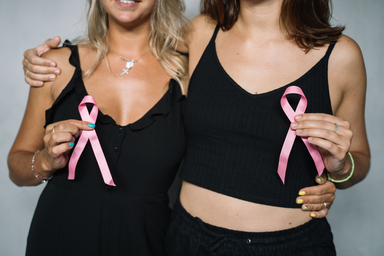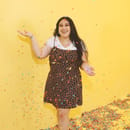October is Breast Cancer Awareness month, and everyone has the responsibility to increase their own awareness of the disease. According to breastcancer.org, breast cancer is, “is an uncontrolled growth of breast cells. The term “breast cancer” refers to a malignant tumor that has developed from cells in the breast. Breast cancer is always caused by a genetic abnormality (a “mistake” in the genetic material)”.
It is overall something that is scary to think about. When you hear the word, “cancer”, a part of you shivers. And for good reason, as there is currently no cure for it, and about 43,600 women in the U.S. are expected to die in 2021 from breast cancer. It is normal to be fearful, and you should not be ashamed of it. Just as it is normal to fear the health of the people around you and their own risks. But that is why we must be aware, so we can help ourselves and those around us when it comes to the disease.
I was fearful. My family has a bad history with cancer, so when my OBGYN found a lump in my breast in 2018 I was terrified. She did the best she could to explain that finding a lump does not automatically mean it is malignant, but I still had to get it checked out with an ultrasound. Thankfully, it was benign, but for those few weeks waiting to get it checked out, and then waiting for results, was scarier than I had ever imagined. I cried in fear when I got home after my OBGYN found the lump, and I cried when I found out it was benign.
But for so many, it isn’t benign. But the best way to treat Breast Cancer is to diagnose it and treat it as quickly as possible. That is where you come in. As breastcancer.org says, “Breast self-exam, or regularly examining your breasts on your own, can be an important way to find a breast cancer early when it’s more likely to be treated successfully”. Here are the five steps they have listed to do a breast self-exam:
Step 1: Begin by looking at your breasts in the mirror with your shoulders straight and your arms on your hips.
Here’s what you should look for:
- Breasts that are their usual size, shape, and color
- Breasts that are evenly shaped without visible distortion or swelling
If you see any of the following changes, bring them to your doctor’s attention:
- Dimpling, puckering, or bulging of the skin
- A nipple that has changed position or an inverted nipple (pushed inward instead of sticking out)
- Redness, soreness, rash, or swelling
Step 2: Now, raise your arms and look for the same changes.
Step 3: While you’re at the mirror, look for any signs of fluid coming out of one or both nipples (this could be a watery, milky, or yellow fluid or blood).
Step 4: Next, feel your breasts while lying down, using your right hand to feel your left breast and then your left hand to feel your right breast. Use a firm, smooth touch with the first few finger pads of your hand, keeping the fingers flat and together. Use a circular motion, about the size of a quarter.
Cover the entire breast from top to bottom, side to side — from your collarbone to the top of your abdomen, and from your armpit to your cleavage.
Follow a pattern to be sure that you cover the whole breast. You can begin at the nipple, moving in larger and larger circles until you reach the outer edge of the breast. You can also move your fingers up and down vertically, in rows, as if you were mowing a lawn. This up-and-down approach seems to work best for most women. Be sure to feel all the tissue from the front to the back of your breasts: for the skin and tissue just beneath, use light pressure; use medium pressure for tissue in the middle of your breasts; use firm pressure for the deep tissue in the back. When you’ve reached the deep tissue, you should be able to feel down to your ribcage.
Step 5: Finally, feel your breasts while you are standing or sitting. Many women find that the easiest way to feel their breasts is when their skin is wet and slippery, so they like to do this step in the shower. Cover your entire breast, using the same hand movements described in step 4.
If you find a lump, don’t panic. Some breasts have natural lumps, but the best way to recognize between “normal” and a new, strange lump, is to consistently check yourself. Making it a routine of once a month will help you memorize your breasts, so you can more easily recognize when a new lump has formed, so you know when to contact your doctor. You should still go see your doctor regularly and have those checkups as well. That is where I found my lump, during my regular checkup, so it shows how vital those appointments are to your health.
As I have mentioned before, it is okay to be a little frightened when thinking about cancer. But you should also feel empowered when you self-examine and recognize that you are taking control of your own body. If you find a worrisome lump, get it checked out. But don’t forget, whether it is malignant or benign (and I do hope for everyone that you either find no lump or it is benign) that by checking yourself and taking action, you are helping yourself.
To go back to my own experience, use me as an example if you have never been close to anyone who had a “scare” or was diagnosed with breast cancer. It was a real, tangible fear during those few weeks, and caused me to recognize my own responsibility to myself. In fact, I wrote a poem about my prior experience, and you can find it here, titled “Winnie the Pooh”. It was a strange experience, and I found myself wondering during those few weeks if this is what it meant to be an adult, as I had just turned 18, and that caused it. That it was my loss of childhood that forced my body to change and create the lump. A warning, a cause, a side effect of growth. But that is all out of my reach, something I cannot change. But what I could change is how I reacted, and how I took care of my body.
Breast cancer is common, and that itself is terrifying. But we must realize that awareness is not something that should be contained to a single month, in fact, be aware of it consistently. We are all responsible for taking care of ourselves, mentally and physically, so it is important to routinely self-examine and go to your doctor’s appointments. It is not just awareness for those who have or are currently experiencing Breast cancer, but awareness for your own sake.


